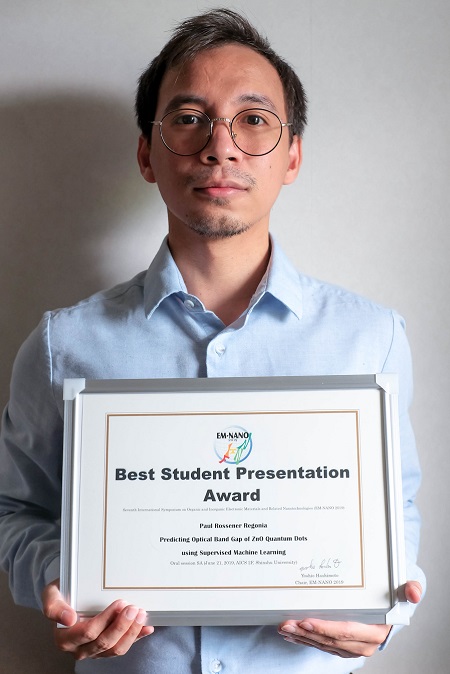数理情報学研究室のPaul Rossener Regoniaさん(博士後期課程2年)が、国際シンポジウムEM-NANO 2019においてBest Student Presentation Awardを受賞しました。
Paul Rossener Regonia, a doctoral student of Mathematical Informatics lab., received the Best Student Presentation Award at the EM-NANO 2019.
(2019/6/21)
|
第7回有機および無機電子材料および関連ナノテクノロジーに関する国際シンポジウム(EM-NANO 2019)は2019年6月19日から22日にかけて、長野市信州大学で開催されました。このシンポジウムは、有機および無機材料に関するあらゆる議題、ならびにエレクトロニクスに関するナノテクノロジーについて議論の場を提供すること目的としています。 The Seventh International Symposium on Organic and Inorganic Electronic Materials and Related Nanotechnologies, EM-NANO 2019, was held in Shinshu University, Nagano City, Japan in June 19-22, 2019. This conference is intended to have a strong strategy providing a forum for discussion all related subjects on organic and inorganic materials and nanotechnologies for electronics. |
- 受賞者 Awardee:
Paul Rossener Regonia

写真はPaul Rossener Regoniaさん
- 受賞テーマ Research theme:
"Predicting Optical Band Gap of ZnO Quantum Dots using Supervised Machine Learning”
This research is a collaborative work between materials science and information science. Here we predicted the optical band gap of zinc oxide (ZnO) quantum dots using different machine learning techniques: Ridge Regression (RR), Kernel Ridge Regression (KRR), and Artificial Neural Networks (ANN). The ZnO quantum dots were synthesized via base-initiated hydrolysis and condensation of Zn ions. In a typical preparation, 6 ml of 0.55M N(Me)4OH in EtOH was slowly added to 0.1M Zn(OAc)2 dissolved in DMSO under constant stirring at varying temperatures. Then the quantum dots were precipitated on varying times, and washed with ethyl acetate.
Using experimental time and temperature conditions as features, we modeled the predictor for ZnO optical band gap. The models were chosen based on their predictive power over small sample size (n=10). We optimized the models using grid search with leave one out cross validation (LOOCV). Our best model was KRR with polynomial features, with 0.007 mean squared error and positive variance scores.
- 著者 Authors:
Paul Rossener Regonia, Christian Mark Pelicano, Ryosuke Tani, Atsushi Ishizumi, Hisao Yanagi and Kazushi Ikeda
- 受賞者のコメント Awardee's voice
This award would not be possible without the help and guidance of my colleagues and professors. I especially want to acknowledge my research partner, Christian Pelicano, for his earnestness in our collaborative work; our head senseis, Prof. Ikeda and Prof. Yanagi, for their support and encouragement; my research supervisor, Prof. Yoshimoto, for giving me freedom to work along the periphery of my thesis topic; and my friends from Division of Materials Science, for helping during my mock presentation. I am looking forward to more collaborative work in materials science.
- 外部リンク Links to:
EM-NANO 2019 HP:http://hashi.shinshu-u.ac.jp/emnano/
This research was supported by https://kaken.nii.ac.jp/ja/grant/KAKENHI-PROJECT-18K19821/, and DOST ERDT-SEI research dissemination grant.
